Army National Guard
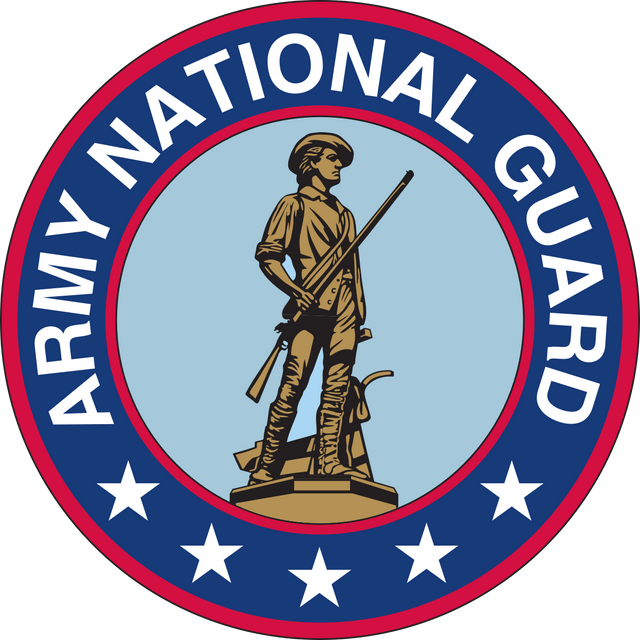
Army National Guard

| Army National Guard | |
|---|---|
| Active | As state-funded militia under various names: 1636–1903 As federal reserve forces called the Army National Guard: 1903–present |
| Country | |
| Size | 343,000 (authorized end strength for Fiscal Year 2018)[1] |
| Part of | |
| Garrison/HQ | Army National Guard Readiness Center, Arlington Hall Arlington County, Virginia, U.S. |
| Nickname(s) | "Army Guard", "The Guard" |
| Anniversaries | 13 December 1636 (founding) |
| Website | www.army.mil/nationalguard [128] |
| Commanders | |
| Director of the Army National Guard | LTG Daniel R. Hokanson |
| Chief, National Guard Bureau | Gen Joseph L. Lengyel |
| Deputy Director of the Army National Guard | Maj. Gen. Charles W. Whittington |
| Command Sergeant Major of the Army National Guard | CSM John F. Sampa |
| Notable commanders | Complete List |
The Army National Guard (ARNG), in conjunction with the Air National Guard, is a militia force and a federal military reserve force of the United States. They are simultaneously part of two different organizations, the Army National Guard of the several states, territories and the District of Columbia (also referred to as the Militia of the United States), and the Army National Guard of the United States, part of the United States National Guard. The Army National Guard is divided into subordinate units stationed in each of the 50 states, three territories, and the District of Columbia, and operates under their respective governors.[2]
The foundation for what became the Army National Guard occurred in the city of Salem, Massachusetts in 1692, the first time that a regiment of militia drilled for the common defense of a multi-community area.[3]
| Army National Guard | |
|---|---|
| Active | As state-funded militia under various names: 1636–1903 As federal reserve forces called the Army National Guard: 1903–present |
| Country | |
| Size | 343,000 (authorized end strength for Fiscal Year 2018)[1] |
| Part of | |
| Garrison/HQ | Army National Guard Readiness Center, Arlington Hall Arlington County, Virginia, U.S. |
| Nickname(s) | "Army Guard", "The Guard" |
| Anniversaries | 13 December 1636 (founding) |
| Website | www.army.mil/nationalguard [128] |
| Commanders | |
| Director of the Army National Guard | LTG Daniel R. Hokanson |
| Chief, National Guard Bureau | Gen Joseph L. Lengyel |
| Deputy Director of the Army National Guard | Maj. Gen. Charles W. Whittington |
| Command Sergeant Major of the Army National Guard | CSM John F. Sampa |
| Notable commanders | Complete List |
Activation
The Army National Guard as currently authorized and organized operates under Title 10 of the United States Code when under federal control, and Title 32 of the United States Code and applicable state laws when under state control. The Army National Guard may be called up for active duty by the state or territorial governors to help respond to domestic emergencies and disasters, such as those caused by hurricanes, floods, and earthquakes, as well as civil disorder.[2] The District of Columbia Army National Guard is a federal militia, controlled by the President of the United States with authority delegated to the Secretary of Defense, and through him to the Secretary of the Army.[4]
Members or units of the Army National Guard may be ordered, temporarily or indefinitely, into the service of the United States.[5][6] If mobilized for federal service, the member or unit becomes part of the Army National Guard of the United States, which is a reserve component of the United States Army.[7][8][9] Individuals volunteering for active federal service may do so subject to the consent of their governors.[10] Governors generally cannot veto involuntary activations of individuals or units for federal service, either for training or national emergency.[11] (See Perpich v. Department of Defense.)
The President may also call up members and units of the Army National Guard, in its status as the militia of the several states, to repel invasion, suppress rebellion, or enforce federal laws.[12] The Army National Guard of the United States is one of two organizations administered by the National Guard Bureau, the other being the Air National Guard of the United States. The Director of the Army National Guard is the head of the organization, and reports to the Chief of the National Guard Bureau. Because the Army National Guard is both the militia of the several states and a federal reserve component of the Army, neither the Chief of the National Guard Bureau nor the Director of the Army National Guard "commands" it. This function is performed in each state or territory by the State Adjutant General, and in the District of Columbia by the Commanding General of the District of Columbia National Guard when a unit is in its militia status. The Chief of the National Guard Bureau and the Director of the Army National Guard serve as the channel of communications between the Department of the Army and the Army National Guard in each state and territory, and administer federal programs, policies, and resources for the National Guard.[13]
The Army National Guard's portion of the president's proposed federal budget for Fiscal Year 2018 is approximately $16.2 billion to support an end strength of 343,000, including appropriations for personnel pay and allowance, facilities maintenance, construction, equipment maintenance and other activities.[14]
History
Presidents who served in Army National Guard
Of the 44 individuals to serve as President of the United States as of 2017, 33 had military experience. Of those 33, 21 served in the militia or Army National Guard.
George Washington, commissioned a Major in the Virginia Militia in 1753. He attained the rank of colonel before resigning his commission at the end of the French and Indian War.[15][16]
Thomas Jefferson, colonel and commander of the Albemarle County Militia at the start of the American Revolution[17]
James Madison, colonel in the Orange County Militia at the start of the American Revolution and aide to his father, James Madison, Sr., who was the commander.[18]
James Monroe, served in the militia while attending the College of William and Mary. After being wounded at the Battle of Trenton while serving in the Continental Army, he returned to Virginia to recruit and lead a regiment as a militia lieutenant colonel, but the regiment was never raised. In 1780 the British invaded Richmond, Virginia, and Jefferson commissioned Monroe as a colonel to command the militia raised in response and act as liaison to the Continental Army in North Carolina.[19][20]
Andrew Jackson, commander of the Tennessee Militia as a Major General prior to the War of 1812.[21][22]
William Henry Harrison, commander of Indiana Territory's militia and Major General of the Kentucky Militia at the start of the War of 1812.[23][24]
John Tyler, commanded a company called the Charles City Rifles, part of Virginia's 52nd Regiment, in the War of 1812.[25]
James Polk, joined the Tennessee Militia as a captain in a cavalry regiment in 1821. He was subsequently appointed a colonel on the staff of Governor William Carroll.[26][27][28][29]
Millard Fillmore, served as inspector of New York's 47th Brigade with the rank of major.[30] Commanded the Union Continentals, a militia unit raised to perform local service in Buffalo, New York, during the American Civil War.[31]
Franklin Pierce, appointed aide de camp to Governor Samuel Dinsmoor in 1831. He remained in the militia until 1847 and attained the rank of colonel before becoming a brigadier general in the Army during the Mexican–American War.[32]
James Buchanan, a member of the Pennsylvania Militia. His dragoon unit took part in the defense of Baltimore, Maryland, during the War of 1812.[33][34]
Abraham Lincoln, served in the Illinois Militia during the Black Hawk War. He commanded a company in the 4th Illinois Regiment with the rank of captain from April to May, 1832. He was a private in Captain Alexander White's Company from May to June, 1832. He served as a private in Captain Jacob Earley's company from June to July, 1832.[35]
Andrew Johnson, served in the Tennessee Militia in the 1830s, and attained the rank of colonel.[36][37] During the American Civil War he remained loyal to the Union and was appointed Military Governor of Tennessee with the rank of brigadier general.[38][39][40]
Ulysses S. Grant, having left the Army as a captain, at the start of the Civil War he served in the Illinois Militia as aide de camp and mustering officer for Governor Richard Yates.[41][42] He held these positions until being appointed commander of the 21st Illinois Infantry, which set him on the path to becoming a general and commander of all Union armies.[43]
Rutherford B. Hayes, joined a militia company in 1846 intending to fight in the Mexican–American War, but resigned because of ill health.[44] Enlisted as a private in a Cincinnati militia company at the start of the Civil War in 1861, and was elected commander with the rank of captain. He was subsequently appointed a major in the 23rd Ohio Infantry, and ended the war as a brigade commander and brevet Major General.[45]
James A. Garfield, commissioned a lieutenant colonel in the Ohio Militia in 1861, he took part in recruiting and training the 42nd Ohio Infantry Regiment, which he commanded as a colonel.[46] He later served as Chief of Staff for the Army of the Cumberland and received promotion to Major General.[47]
Chester A. Arthur, became a member of the New York Militia soon after becoming a lawyer. During the Civil War he served on the staff of Governor Edwin D. Morgan as Quartermaster General with the rank of brigadier general. He later served as Morgan's inspector general, responsible for visiting New York's front line units, assessing conditions and recommending improvements.[48]
Benjamin Harrison, commissioned in the Indiana Militia by Governor Oliver P. Morton to recruit a regiment during the Civil War, he was subsequently appointed a second lieutenant and captain in and then colonel and commander of the 70th Indiana Infantry Regiment. He received the brevet of brigadier general as a commendation of his service, and later commanded a brigade.[49][50][51] He also enrolled in the militia again during labor unrest in Indianapolis in 1877.[52]
William McKinley, joined a volunteer militia company called the Poland Guards at the start of the Civil War. The company was subsequently mustered in as part of the 23rd Ohio Infantry, the same regiment in which President Hayes served. McKinley ended the war as a major and chief of staff for division commander Samuel S. Carroll.[53][54]
Theodore Roosevelt, commissioned as a second lieutenant in the 8th New York Infantry Regiment in 1884, he served until 1888 and attained the rank of captain. During the Spanish–American War he was commissioned lieutenant colonel of the 1st United States Volunteer Cavalry, which he later commanded as a colonel. In 2001 a review of his war record led to a posthumous award of the Medal of Honor.[55][56]
Harry S. Truman, served in the Missouri Army National Guard from 1905 to 1911, rising to the rank of corporal. During World War I he rejoined and was commissioned a first lieutenant in the 2nd Missouri Field Artillery. This regiment was federalized as the 129th Field Artillery, and Truman commanded Battery D as a captain. He continued to serve in the Army Reserve, retiring as a colonel in 1953.[57][58][59]
(Note: President George W. Bush served in the National Guard in the late 1960s and early 1970s, and he was the first Air National Guard member to attain the presidency.)[60]
Prominent members
Directors
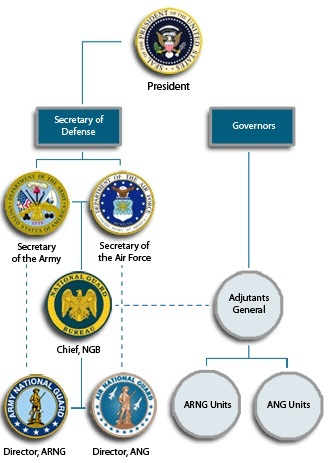
National Guard Bureau organizational chart depicting command and reporting relationships
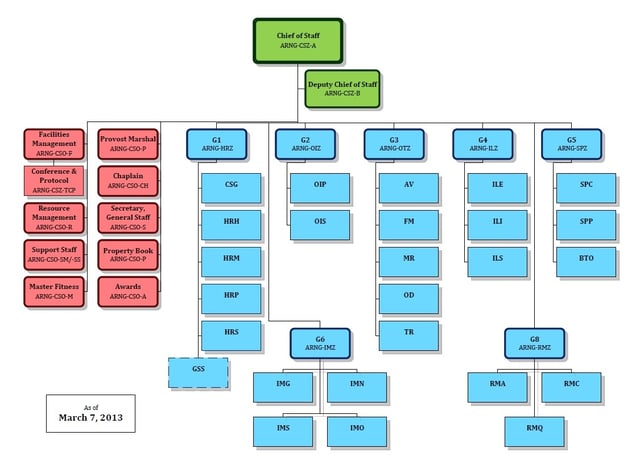
Army National Guard staff organizational chart
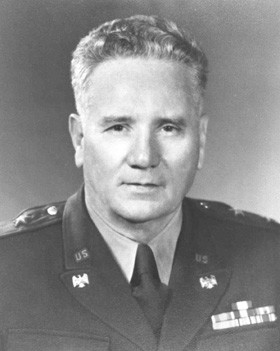
Raymond H. Fleming, first director of the Army National Guard
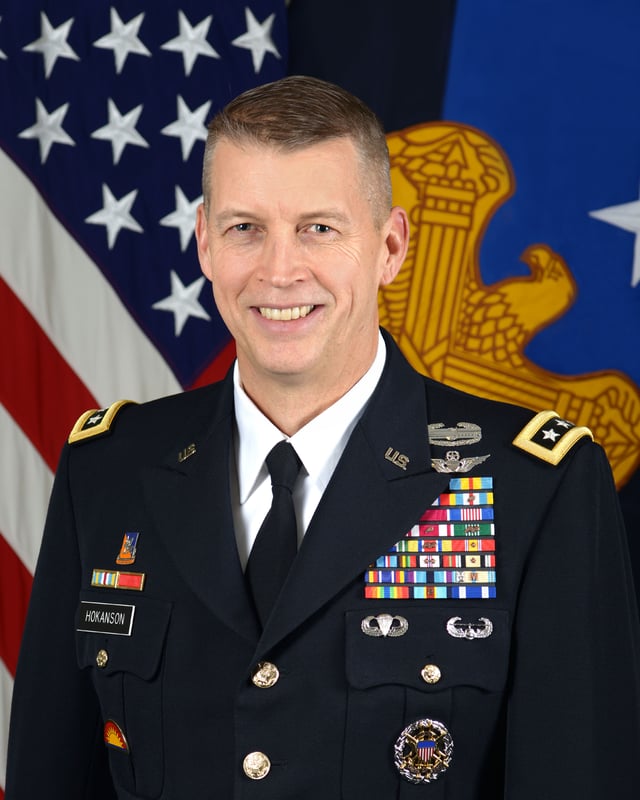
Daniel R. Hokanson is the current director of the Army National Guard.
Upon the creation of the United States Air Force in 1947, which included the Air National Guard, the National Guard Bureau was organized into two divisions, Army and Air, each headed by a major general who reported to the Chief of the National Guard Bureau. Each Director's position was later upgraded to a lieutenant general's assignment. The Army National Guard is also authorized a deputy director. Originally a brigadier general, the post was later upgraded to major general. Individuals who served as director or deputy director and subsequently served as NGB Chief include: Fleming; McGowan; Greenlief; Weber; Temple; Rees (acting); and Grass.
The Director of the Army National Guard oversees a staff which aids in planning and day-to-day organization and management. In addition to a chief of staff, the Director's staff includes several special staff members, including a chaplain and protocol and awards specialists. It also includes a primary staff, which is organized as directorates, divisions, and branches. The directorates of the Army National Guard staff are arranged along the lines of a typical American military staff: G-1 for personnel; G-2 for intelligence; G-3 for plans, operations and training; G-4 for logistics; G-5 for strategic plans, policy and communications; G-6 for communications; and G-8 for budgets and financial management.
The following is a list of the Directors of the Army National Guard since the creation of the position:
MG Raymond H. Fleming, 1948–1950
MG William H. Abendroth, 1951–1955
MG Donald W. McGowan, 1955–1959
MG Clayton P. Kerr, 1959–1962
BG Francis S. Greenlief, 1962–1963
BG Charles L. Southward, 1964–1967
BG Leonard C. Ward, 1968–1970
MG Francis S. Greenlief, 1970–1971
MG La Vern E. Weber, 1971–1974
MG Charles A. Ott, Jr., 1974–1978
MG Emmett H. Walker, Jr., 1978–1982
MG Herbert R. Temple, Jr., 1982–1986
MG Donald Burdick, 1986–1991
MG Raymond F. Rees, 1991–1992
MG John R. D'Araujo, Jr., 1993–1995
MG William A. Navas, Jr., 1995–1998
LTG Roger C. Schultz, 1998–2005[61]
LTG Clyde A. Vaughn, 2005–2009[62]
MG Raymond W. Carpenter (Acting), 2009–2011[63]
MG Judd H. Lyons (Acting), 2014–2015[66]
LTG Timothy J. Kadavy, 2015–2019[67]
MG Charles W. Whittington (acting), 2019[68]
LTG Daniel R. Hokanson, 2019-Present[68]
Deputy Directors

Judd H. Lyons, Deputy Director of Army National Guard, 2013–2015
The individuals who have served as Deputy Director since 1970 are:
BG Leonard C. Ward, 1970–1972[69]
BG Joseph R. Jelinek, 1973–1976[70]
BG Emmett H. Walker, Jr., 1977[71]
BG Herbert R. Temple, Jr., 1978–1981[72]
BG Richard D. Dean, 1982–1986[73]
BG William A. Navas, Jr., 1987–1990[74]
BG John R. D'Araujo, Jr., 1990–1993[75]
BG William C. Bilo, 1993–1997[76]
BG Michael J. Squier, 1998–2002[77]
BG Clyde A. Vaughn, 2002–2003[78]
MG Frank J. Grass, 2004–2006[79]
MG James W. Nuttall, 2006–2009[80]
MG Raymond W. Carpenter, 2009[81]
MG Timothy J. Kadavy, 2009–2013[82]
BG Walter E. Fountain (Acting), 2013[83]
BG Walter E. Fountain (Acting), 2014–2015[84]
MG Judd H. Lyons, 2015[85]
BG Walter E. Fountain (Acting), 2015[86]
BG Timothy J. Wojtecki (Acting), 2015[87]
MG Timothy M. McKeithen, 2015 –2018[88]
MG Charles W. Whittington, 2018 – present[89]
Units and formations
Deployable Army units are organized as table of organization and equipment (TOE) or modified table of organization (MTOE) organizations. Non-deployable units, such as a state's joint force headquarters or regional training institute are administered as table of distribution and allowance (TDA) units.[90]
Commands
46th Military Police Command (46th MPC) (MI ARNG)
66th Theater Aviation Command (66th TAC) (WA ARNG)
135th Sustainment Command (Expeditionary) (135th ESC) (AL ARNG)
167th Sustainment Command (Theater) (167th TSC) (AL ARNG)
184th Sustainment Command (Expeditionary) (184th ESC) (MS ARNG)
263rd Army Air and Missile Defense Command (263rd AAMDC) (SC ARNG)
Divisions

28th Division

29th Division

34th Division

35th Division

36th Division

38th Division

40th Division

42nd Division
In addition to many deployable units which are non-divisional, the Army National Guard's deployable units include eight Infantry divisions.[91] These divisions, their subordinate brigades or brigades with which the divisions have a training oversight relationship, and the states represented by the largest units include:[92]
28th Infantry Division (PA ARNG) 2nd Infantry Brigade Combat Team (2nd IBCT) (PA ARNG) 56th Stryker Brigade Combat Team (56th SBCT) (PA ARNG) 28th Combat Aviation Brigade (28th CAB) (PA ARNG)
29th Infantry Division (VA ARNG) 30th Armored Brigade Combat Team (30th ABCT) (NC ARNG) 53rd Infantry Brigade Combat Team (53rd IBCT) (FL ARNG) 116th Infantry Brigade Combat Team (116th IBCT) (VA ARNG) 29th Combat Aviation Brigade (29th CAB) (MD ARNG)
34th Infantry Division (MN ARNG) 1st Armored Brigade Combat Team (1st ABCT) (MN ARNG) 2nd Infantry Brigade Combat Team (2nd IBCT) (IA ARNG) 32nd Infantry Brigade Combat Team (32nd IBCT) (WI ARNG) 116th Cavalry Brigade Combat Team (116th CBCT) (ID ARNG) 34th Combat Aviation Brigade (34th CAB) (MN ARNG)
35th Infantry Division (KS ARNG) 33rd Infantry Brigade Combat Team (33rd IBCT) (IL ARNG) 39th Infantry Brigade Combat Team (39th IBCT) (AR ARNG) 45th Infantry Brigade Combat Team (45th IBCT) (OK ARNG) 35th Combat Aviation Brigade (35th CAB) (MO ARNG)
36th Infantry Division (TX ARNG) 3rd Infantry Brigade Combat Team (3rd IBCT) (Regular Army) (formerly of the 10th Mountain Division) 56th Infantry Brigade Combat Team (56th IBCT) (TX ARNG) 72nd Infantry Brigade Combat Team (72nd IBCT) (TX ARNG) 155th Armored Brigade Combat Team (155th ABCT) (MS ARNG) 256th Infantry Brigade Combat Team (256th IBCT) (LA ARNG) 36th Combat Aviation Brigade (36th CAB) (TX ARNG)
38th Infantry Division (IN ARNG) 37th Infantry Brigade Combat Team (37th IBCT) (OH ARNG) 76th Infantry Brigade Combat Team (76th IBCT) (IN ARNG) 278th Armored Cavalry Regiment (278th ACR) (TN ARNG) 38th Combat Aviation Brigade (38th CAB) (IN ARNG)
40th Infantry Division (CA ARNG) 29th Infantry Brigade Combat Team (29th IBCT) (HI ARNG) 41st Infantry Brigade Combat Team (41st IBCT) (OR ARNG) 79th Infantry Brigade Combat Team (79th IBCT) (CA ARNG) 40th Combat Aviation Brigade (40th CAB) (CA ARNG)
42nd Infantry Division (NY ARNG) 27th Infantry Brigade Combat Team (27th IBCT) (NY ARNG) 50th Infantry Brigade Combat Team (50th IBCT) (NJ ARNG) 42nd Combat Aviation Brigade (42nd CAB) (NY ARNG)
Multifunctional Support Brigades
The Army National Guard fields 37 multifunctional support brigades.
Maneuver Enhancement Brigades
26th Maneuver Enhancement Brigade (26th MEB) (MA ARNG)
55th Maneuver Enhancement Brigade (55th MEB) (PA ARNG)
67th Maneuver Enhancement Brigade (67th MEB) (NE ARNG)
110th Maneuver Enhancement Brigade (110th MEB) (MO ARNG)
130th Maneuver Enhancement Brigade (130th MEB) (NC ARNG)
136th Maneuver Enhancement Brigade (136th MEB) (TX ARNG)
141st Maneuver Enhancement Brigade (141st MEB) (ND ARNG)
149th Maneuver Enhancement Brigade (149th MEB) (KY ARNG)
157th Maneuver Enhancement Brigade (157th MEB) (WI ARNG)
158th Maneuver Enhancement Brigade (158th MEB) (AZ ARNG)
196th Maneuver Enhancement Brigade (196th MEB) (SD ARNG)
204th Maneuver Enhancement Brigade (204th MEB) (UT ARNG)
218th Maneuver Enhancement Brigade (218th MEB) (SC ARNG)
226th Maneuver Enhancement Brigade (226th MEB) (AL ARNG)
404th Maneuver Enhancement Brigade (404th MEB) (IL ARNG)
648th Maneuver Enhancement Brigade (648th MEB) (GA ARNG)
Field Artillery Brigades
45th Field Artillery Brigade (45th FAB) (OK ARNG)
65th Field Artillery Brigade (65th FAB) (UT ARNG)
115th Field Artillery Brigade (115th FAB) (WY ARNG)
130th Field Artillery Brigade (130th FAB) (KS ARNG)
138th Field Artillery Brigade (138th FAB) (KY ARNG)
142nd Field Artillery Brigade (142nd FAB) (AR ARNG)
169th Field Artillery Brigade (169th FAB) (CO ARNG)
197th Field Artillery Brigade (197th FAB) (NH ARNG)
Sustainment Brigades
17th Sustainment Brigade (NV ARNG)
36th Sustainment Brigade (TX ARNG)
38th Sustainment Brigade (IN ARNG)
108th Sustainment Brigade (IL ARNG)
111th Sustainment Brigade (NM ARNG)
113th Sustainment Brigade (NC ARNG)
224th Sustainment Brigade (CA ARNG)
230th Sustainment Brigade (TN ARNG)
369th Sustainment Brigade (NY ARNG)
371st Sustainment Brigade (OH ARNG)
Military Intelligence Brigades
58th Military Intelligence Brigade (Expeditionary) (58th EMIB) (MD ARNG)
71st Military Intelligence Brigade (Expeditionary) (71st EMIB) (TX ARNG)
300th Military Intelligence Brigade (Linguist) (300th MIB) (UT ARNG)
Functional Support Brigades & Groups
Engineer Brigades
16th Engineer Brigade (OH ARNG)
35th Engineer Brigade (MO ARNG)
111th Engineer Brigade (WV ARNG)
117th Engineer Brigade (SC ARNG)
168th Engineer Brigade (MS ARNG)
176th Engineer Brigade (TX ARNG)
194th Engineer Brigade (TN ARNG)
219th Engineer Brigade (IN ARNG)
225th Engineer Brigade (LA ARNG)
Air Defense Artillery Brigades
164th Air Defense Artillery Brigade (164th ADAB) (FL ARNG)
174th Air Defense Artillery Brigade (174th ADAB) (OH ARNG)
678th Air Defense Artillery Brigade (678th ADAB) (SC ARNG)
Theater Tactical Signal Brigades
228th Theater Tactical Signal Brigade (228th TTSB) (SC ARNG)
261st Theater Tactical Signal Brigade (261st TTSB) (DE ARNG)
Military Police Brigades
35th Military Police Brigade (35th MPB) (MO ARNG)
43rd Military Police Brigade (43rd MP BDE) (RI ARNG)
49th Military Police Brigade (49th MP BDE) (CA ARNG
92nd Military Police Brigade (92nd MP BDE) (PR ARNG
177th Military Police Brigade (177th MP BDE) (MI ARNG)
Theater Aviation Brigades
63rd Theater Aviation Brigade (63rd TAB) (KY ARNG)
77th Theater Aviation Brigade (77th TAB) (AR ARNG)
185th Theater Aviation Brigade (185th TAB) (MS ARNG)
449th Theater Aviation Brigade (449th TAB) (NC ARNG)
Other Brigades
31st Chemical Brigade (AL ARNG)
100th Missile Defense Brigade (CO ARNG)
Special Forces, Explosive Ordnance Disposal, Theater Information Operations, Theater Aviation Sustainment Maintenance, and Regional Support Groups
19th Special Forces Group (19th SFG) (UT ARNG)
20th Special Forces Group (20th SFG) (AL ARNG)
111th Explosive Ordnance Disposal Group (111th EODG) (AL ARNG)
56th Theater Information Operations Group (56th TIOG) (WA ARNG)
71st Theater Information Operations Group (71st TIOG) (TX ARNG)
204th Theater Airfield Operations Group (204th TAOG) (LA ARNG)
1100th Theater Aviation Sustainment Maintenance Group (1100th TASMG) (MD ARNG)
1106th Theater Aviation Sustainment Maintenance Group (1106th TASMG) (CA ARNG)
1107th Theater Aviation Sustainment Maintenance Group (1107th TASMG) (MO ARNG)
1108th Theater Aviation Sustainment Maintenance Group (1108th TASMG) (MS ARNG)
1109th Theater Aviation Sustainment Maintenance Group (1109th TASMG) (CT ARNG)
42nd Regional Support Group (42nd RSG) (NJ ARNG)
50th Regional Support Group (50th RSG) (FL ARNG)
109th Regional Support Group (109th RSG) (SD ARNG)
115th Regional Support Group (115th RSG) (CA ARNG)
120th Regional Support Group (120th RSG) (ME ARNG)
139th Regional Support Group (139th RSG) (LA ARNG)
143rd Regional Support Group (143rd RSG) (CT ARNG)
151st Regional Support Group (151st RSG) (MA ARNG)
191st Regional Support Group (191st RSG) (PR ARNG)
198th Regional Support Group (198th RSG) (AZ ARNG)
201st Regional Support Group (201st RSG)] (GA ARNG)
213th Regional Support Group (213th RSG) (PA ARNG)
272nd Regional Support Group (272nd RSG) (MI ARNG)
297th Regional Support Group (297th RSG) (AK ARNG)
329th Regional Support Group (329th RSG) (VA ARNG)
347th Regional Support Group (347th RSG) (MN ARNG)
635th Regional Support Group (635th RSG) (KS ARNG)
734th Regional Support Group (734th RSG) (IA ARNG)
1889th Regional Support Group (1889th RSG) (MT ARNG)
Regular Army – Army National Guard Partnership
In 2016, the Army and the Army National Guard began a training and readiness initiative that aligned some Army brigades with National Guard division headquarters, and some National Guard brigades with Army division headquarters. Among others, this program included the National Guard's 86th Infantry Brigade Combat Team becoming affiliated with the Army's 10th Mountain Division[93] and the National Guard's 1st Battalion, 143rd Infantry Regiment affiliating with the Army's 173rd Airborne Brigade Combat Team.[94] In addition, 3rd Brigade Combat Team, 10th Mountain Division began an affiliation with the National Guard's 36th Infantry Division.[95]
48th Infantry Brigade Combat Team (GA ARNG), associated with 3rd Infantry Division
81st Stryker Brigade Combat Team (WA ARNG), associated with 7th Infantry Division
86th Infantry Brigade Combat Team (VT ARNG), associated with 10th Mountain Division
1st Battalion, 143rd Infantry Regiment (TX ARNG), associated with 173rd Airborne Brigade Combat Team
1st Battalion, 151st Infantry Regiment (IN ARNG), associated with 2nd Brigade Combat Team, 25th Infantry Division
840th Engineer Company (TX ARNG), associated with 36th Engineer Brigade
249th Transportation Company (TX ARNG), associated with 1st Cavalry Division Sustainment Brigade
1176th Transportation Company (TN ARNG), associated with 101st Sustainment Brigade
1245th Transportation Company (OK ARNG), associated with 1st Cavalry Division Sustainment Brigade
2123rd Transportation Company (KY ARNG), associated with 101st Sustainment Brigade
In addition, United States Army Reserve units participating in the program include:
100th Infantry Battalion, 442nd Infantry Regiment, associated with 3rd Brigade Combat Team, 25th Infantry Division.
824th Quartermaster Company, associated with 82nd Sustainment Brigade.
Army units partnering with Army National Guard headquarters include:
3rd Brigade Combat Team, 10th Mountain Division, associated with 36th Infantry Division (TX ARNG).
5th Engineer Battalion, associated with 35th Engineer Brigade (MO ARNG).
By state
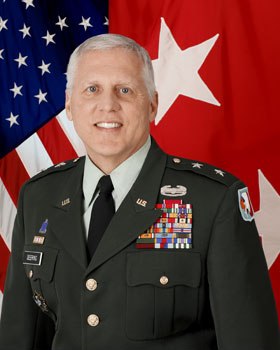
Myles Deering, State Adjutant General of Oklahoma, 2009–2014
The Army and Air National Guard in each state are headed by the State Adjutant General. The Adjutant General (TAG) is the de facto commander of a state's military forces, and reports to the state governor.[96]
Legacy units and formations

Shoulder sleeve insignia of 47th Infantry Division, inactivated 1991

Shoulder sleeve insignia of 50th Armored Division, inactivated 1993
Several units have been affected by Army National Guard reorganizations. Some have been renamed or inactivated. Some have had subordinate units reallocated to other commands. A partial list of inactivated major units includes:
26th Infantry Division, inactivated 1 September 1993.[97]
27th Infantry Division, reorganized as 27th Armored Division, 1 February 1955. (See below.)[98]
27th Armored Division, inactivated 1 February 1968.[99]
30th Armored Division, inactivated 1 December 1973. (See below.)[100]
30th Infantry Division, inactivated 4 January 1974.[101]
31st Infantry Division, inactivated 14 January 1968. Units allocated to 30th Armored Division.[102]
32nd Infantry Division, inactivated 1 December 1967.[103]
33rd Infantry Division, inactivated 1 February 1968.[104]
37th Infantry Division, inactivated 15 February 1968.[105]
39th Infantry Division, inactivated 1 December 1967.[106]
40th Armored Division, inactivated 29 January 1968.[107]
41st Infantry Division, inactivated 1 January 1968.[108][109]
43rd Infantry Division, inactivated 16 December 1967.[110]
44th Infantry Division, inactivated 10 October 1954.[111]
45th Infantry Division, inactivated 1 February 1968.[112]
46th Infantry Division, inactivated 1 February 1968.[113]
47th Infantry Division, inactivated 10 February 1991.[114]
48th Armored Division, inactivated 29 January 1968.[115]
49th Armored Division, inactivated 1 May 2004; reflagged as the 36th Infantry Division.[116][117]
50th Armored Division, inactivated 1 September 1993.[118]
See also
Comparable organizations
United States Army Reserve
United States Marine Corps Reserve
United States Coast Guard Reserve
Air National Guard (U.S. Air Force)
Air Force Reserve Command (U.S. Air Force)